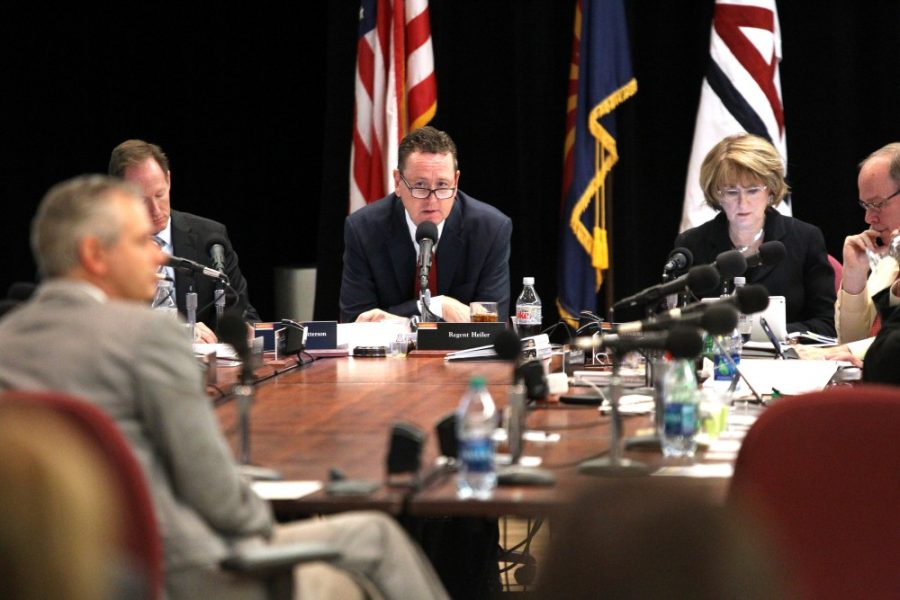The Arizona Board of Regents unanimously approved President Ann Weaver Hart’s tuition proposal at its final board meeting of the semester Thursday.
Hart’s proposal included tuition increases for every new incoming student and every current student who didn’t opt-in for the tuition guarantee program, as well as slight fee increases and the creation of 11 new program fees.
Approved Tuition proposal highlights for the UA main campus:
- 3.2 percent increase in tuition and mandatory fees for incoming new resident undergraduate students, a $366 increase
- 2.8 percent increase in tuition and mandatory fees for continuing resident undergraduate students who did not opt-in for the tuition guarantee program, a $299 increase
- 7.2 percent increase in tuition and mandatory fees for incoming new nonresident undergraduate students, a $2,337 increase
- 5.8 percent increase in tuition and mandatory fees for continuing nonresident undergraduate students who did not opt-in for the tuition guarantee program, a $1,745 increase
- 2.8 percent increase in tuition and mandatory fees for incoming resident graduate students who did not opt-in for the tuition guarantee, a $335 increase
- 5.8 percent increase in tuition and mandatory fees for incoming nonresident graduate students who did not opt-in for the tutition guarantee, a $1,765 increase
There will also be an increase to two existing differential tuition and program fees, three new program fees created for undergraduate students and eight new program fees for graduate students.
Five existing class fees will see increases and there will now be a new humanities class fee.
UA undergraduate housing costs across campus will see an increase of 4 percent, roughly $275 per year.
The board reiterated throughout the meeting the importance of keeping tuition costs low for students and their families, and the need to strengthen the partnership with the state in order to bounce back from the $99 million budget cut last year.
Hart said they’re working hard to keep costs low for students and that members of the board care deeply about tuition.
“We really are committed to finding a solution to this national dilemma,” Hart said.
She thanked the student leaders of Associated Students of the University of Arizona and Graduate Student Professional Council for putting in their time to work together, understand the tuition process and give their input.
She said that ASUA and GPSC have given their perspectives and the board is committed to continuing its partnership with student leaders in the future to hear the student voice.
Board facts and figures
The incremental gross tuition and fee revenues are estimated to be $219.2 million under Hart’s tuition proposals, according to the regents’ executive summary, included in their agenda.
The agenda stated the breakdown is $191.5 million from base tuition and $27.7 million from differential, program, class and mandatory fees.
Of the $191.5 million in base tuition, 72 percent or $137.9 million is attributed to enrollment growth and change in the mix of students. Twenty-eight percent or $52..6 million is from rate increases.
The average student cost for a UA bachelor’s degree has decreased by 9 percent in the last few years, according to Hart.
The average proposal increase for all three universities is 2.9 percent, which is down from 3.7 percent last year and 19 percent in the fiscal year of 2012, according to board of regents President Eileen Klein’s report slideshow.
Tuition process
John Arnold, vice president for business management and financial affairs, said when setting base tuition, the board considers the following factors:
1. The amount of state support provided to the university system
2. The availability of student financial aid as outlined in the board’s financial aid policies
3. The median of tuition and mandatory fees charged by the university’s peers
4. Other student fees and charges established by each university
5. The cost of university attendance
6. Revenues required to service bonded indebtedness
7. Arizona’s median family income levels
8. Evidence of student consultation
Transparency is vital and ensures accountability in the tuition setting process, Klein said.
Arnold also said the board is already looking ahead and making preparations for tuition setting next year by looking at the impacts of tuition guarantee programs and the process of setting tuition.
Follow Chastity Laskey on Twitter.









